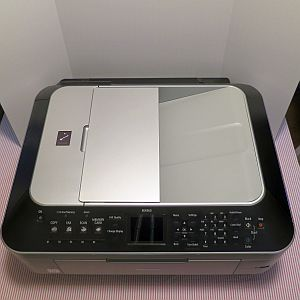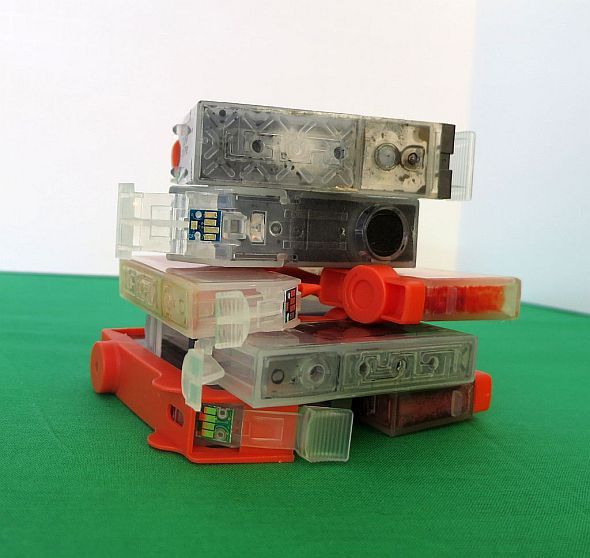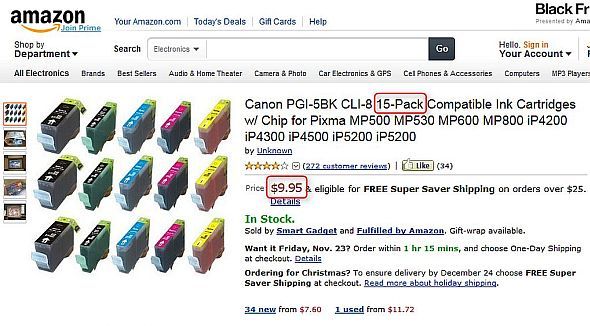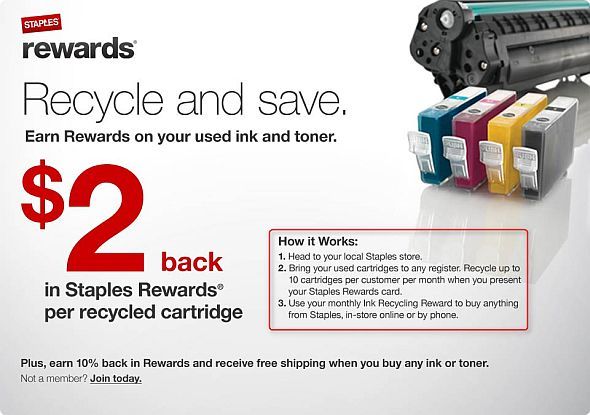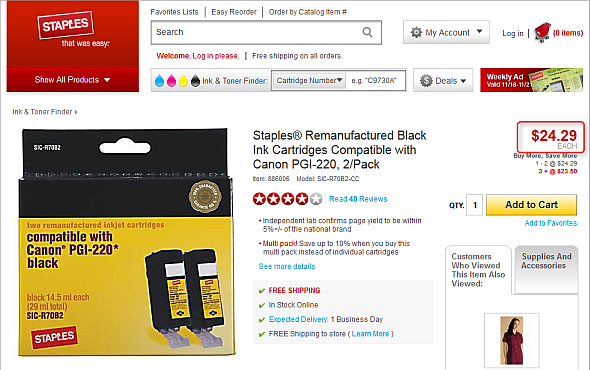Ironically, while printer ink costs more than champagne, cost-savvy consumers can actually make money using their inkjet. It just takes three simple steps—none of which lead to jail.
Clearly, printer ink is expensive: It costs up to $800 a gallon, an unfortunate fact inkjet users feel deeply about because of the looming holiday season and never-ending global recession.
Companies selling ink charge outrageous sums by design: Each cartridge contains a special computer chip preventing third parties from building knockoffs. Fiendishly, with supply controlled by a single manufacturer, brand-new ink clip prices have reached outrageous sums. Fortunately, some companies recycle chips from expended clips, creating inexpensive, remanufactured products, to the dismay of printer makers. While these clips are not known for their quality, I have used them for years without a single problem.
In addition to saving consumers' money, selling or donating rebuilt ink cartridges offers an environmentally friendly alternative to the rubbish bin. Also, aside from being inexpensive and eco-friendly, it can be profitable.
The process is simple: First, buy remanufactured ink clips. Second, sell the used clips back to brick and mortar companies. Third, and optionally,use ink saving tips to reduce wear and tear on your printer and bank account.
However, be aware that there are strong limitations: using this method can yield a maximum of $20 per month in the equivalent of gift cards. These gift cards, also known as "rewards" cards, lock users into purchasing products from the company of issuance. So if you sell your clips to Staples then you can only redeem your credit there.
Let me illustrate the process for you in three steps...
Step 1: Buy Cheap Ink
After finding a good deal on ink, buy packs of 10 or more. Alternatively, according to Yahoo Answers user Georgee, you can purchase empty clips in volume from the same place many remanufacturers do—however, keep in mind that Staple’s program allows for a maximum of ten clips per month.
For larger quantities of clips, Amazon is one of the best places to begin looking. For example, the prices on notoriously inexpensive ink, such as for the Canon MX700 Inkjets, fall as low as $0.77 each.
Remanufacturers can sell ink cartridges for extremely low prices because of a simple system: They purchase empty clips for a fraction of what brick and mortar shops charge, which is made possible by the grossly overpriced first-party ink clips. After buying used cartridges, these companies "remanufacture" them by simply refilling ink. The final rebuilt product, as sold by Staples, costs a whopping $24.29 for a two pack!
On the downside, these clips aren't perfect replacements for manufacturer-fresh replacements. There was an initial scare campaign by printer manufacturers, who claimed that rebuilt clips voided the printer's warranty. Fortunately, US laws permit use of remanufactured clips without voiding the warranty.
Step 2: Sell Your Clips
For those residing in the United States, retail supply stores Office Depot and Staples both purchase used ink clips direct from consumers for two dollars each, in store credit. This greatly exceeds the price other online retailers offer.
While some might balk at the idea of store credit instead of cash, both companies frequently have excellent sales, so having a credit with either corporation isn't such a bad deal, particularly since it can be stacked with other in-store offers.
Step 3: Maximize Returns
Just because each clip is virtually free doesn't mean you should start stockpiling ink or begin madly dashing off print-jobs.
As previously mentioned, both Staples and Office Depot lock customers into a “rewards” program. These restrictions only permit purchases from within the store, similar to gift cards. Additionally, these credits expire over a year's time, so overdoing it simply wastes money. Consequently, even when printing is free, it helps to conserve one's ink consumption.
Another important consideration is printer longevity. Reducing the workload of your printer will extend its life as the greater volume of print jobs a printer completes, the more wear and tear it suffers. Ultimately, every ink drop saved translates into discounted office supplies—so do try and squeeze every bit of ink out of your cartridges but don't break your printer doing so.
Given these factors, I advocate using your ink clips entirely before exchanging them. Also, because Staples limits customers to 10 clip resales each month, purchase approximately ten cartridges at a time.
Conclusion
Profiting from reselling remanufactured ink clips is ridiculously easy and eco-friendly. Simply buy in quantity from Amazon then resell the used clips to Staples (or other brick and mortar stores with recycling programs).
It won’t take long for Staples and Office Depot to reevaluate, or cancel, its ink recycling program. For good reason: By engaging in goods-arbitrage through Amazon and, other retailers, it’s possible to actually turn a profit in a business designed to fleece consumers. This loophole clearly cannot last because anyone with internet access can quickly use this exploit to make printing profitable.
Also, rumors have surfaced suggesting impending changes in the corporations' recycling programs: According to SlickDeals, Office Depot no longer accepts remanufactured ink clips. However, I myself have resold remanufactured clips within the past six months, so your mileage may vary.
My personal experience with Staples, and to some extent Office Depot, has been hiccup-free—they take every single ink clip, no matter how dirty or used, and several months later, have always delivered my store credit.
Unfortunately, as the recycling program increases in popularity, so too does the likelihood that someone at the corporations might catch on. So get free ink before it’s gone!

